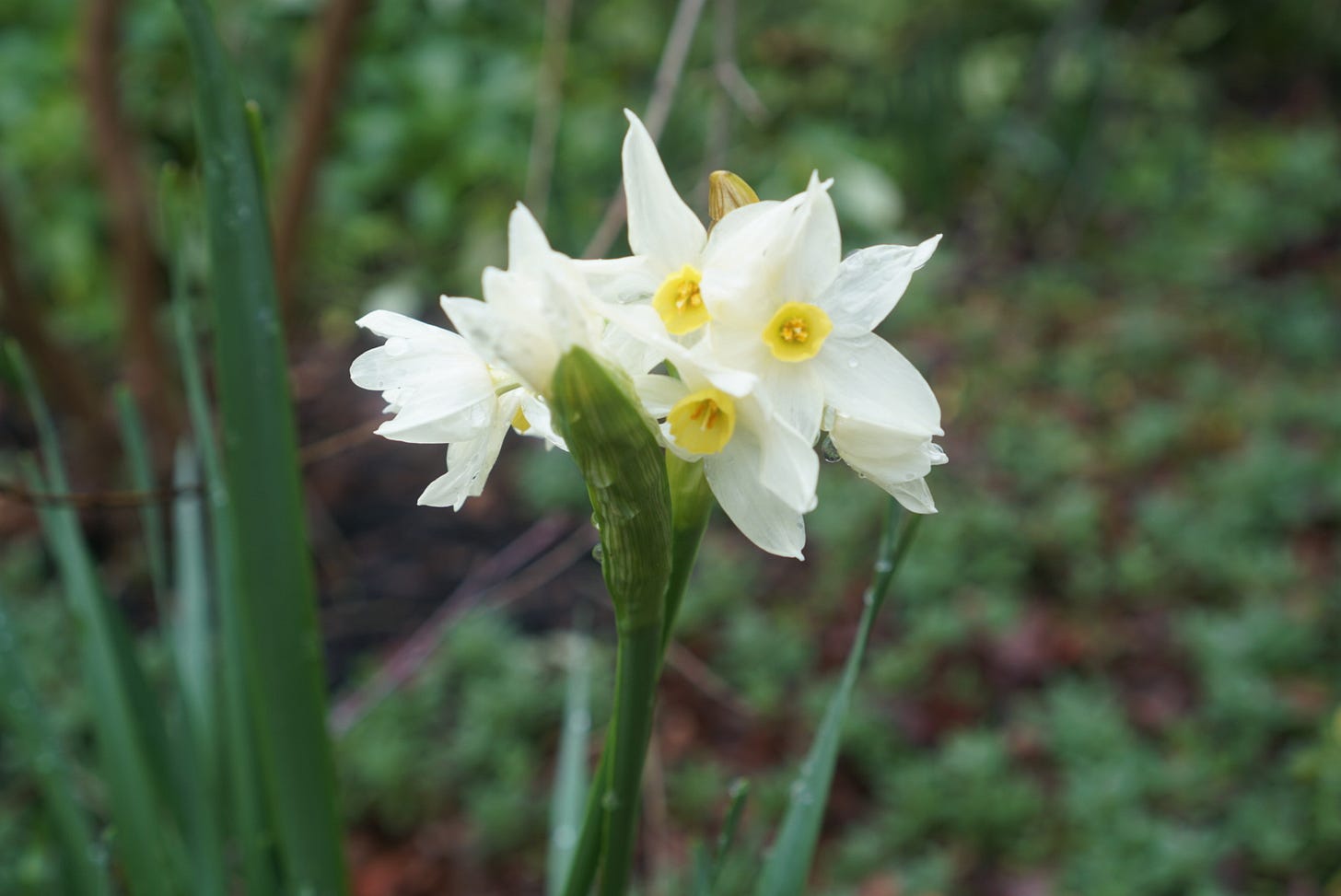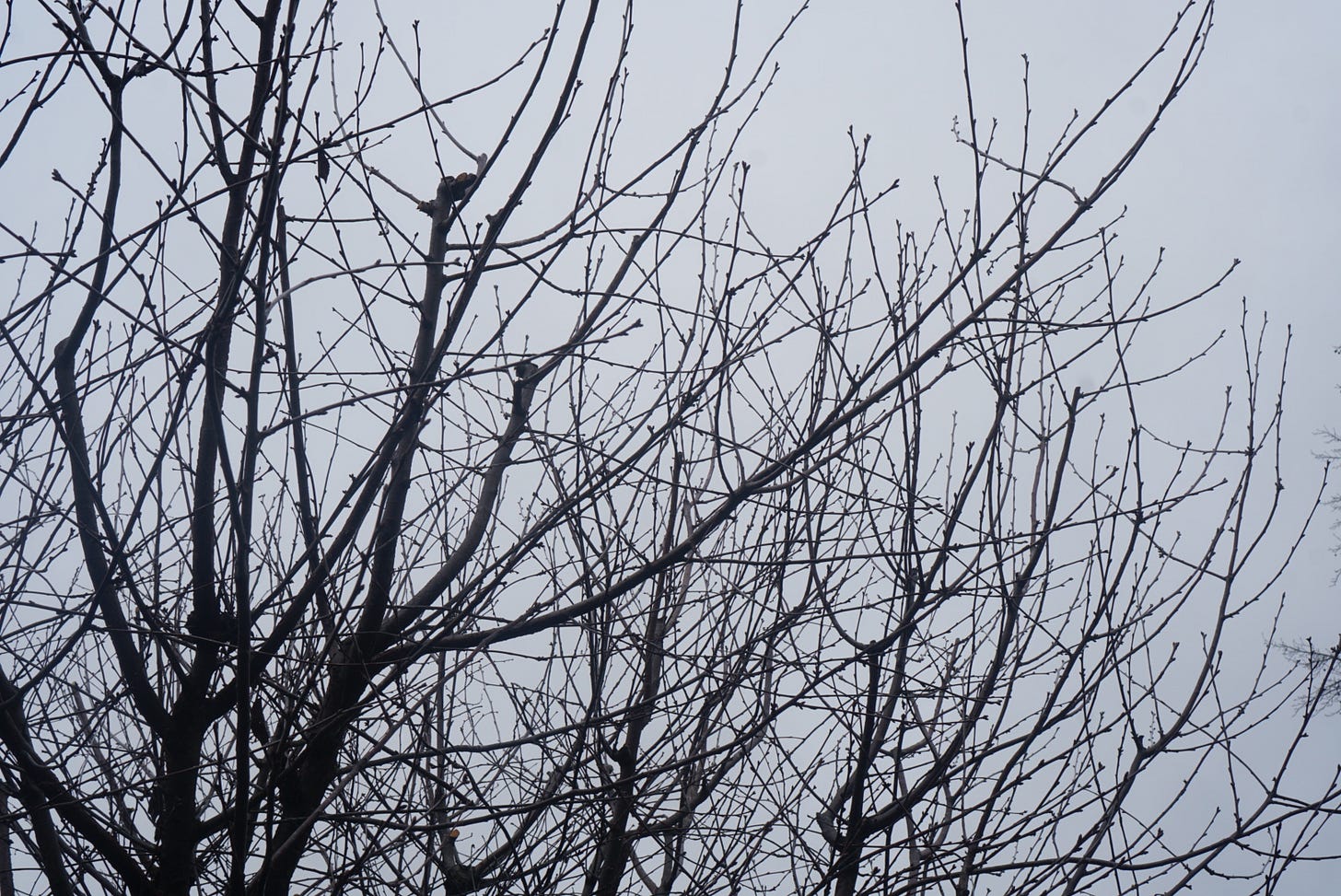Welcome to mama eats, a weekly newsletter inspired by a simple + seasonal home life. This week’s post, postcard from the garden, is free to all readers. I try to provide as much free content as possible, however, this newsletter is a labor of love. If you have the means, and find value in what I share here, please consider becoming a paid subscriber, which also gives you access the the growing archive (posts older than a month).
January in the garden here is grey skies, brown muddy earth, bare skeletons of trees silhouetted against the sky, the last rose hips clinging obstinately onto the canes, their dayglo brightness a jarring contrast amongst all the muted tones. It’s been a mild winter here so far, but we have started to get lots of rain. It’s not a very beautiful month in the garden, I’ve got almost nothing blooming, but nonetheless there is beauty here. My lettuces, fennel, carrots and greens are soldiering on, buoyed by the wet weather. Ranunculus and bulbs are pushing themselves up through the earth, always such an exciting sight to find another one, little easter eggs. The first narcissus bloomed yesterday, emerging from its papery cocoon, perfuming the air so strongly that I smelled it before I saw it. These little bits are more than enough to last me through till almond blossoms and bulbs come next month. Here are some jobs I’ve completed or need to complete in the garden this month. Although there is not a lot of growing or harvesting happening, this is actually quite a busy time of preparation for the warm season to come.
pruning fruit trees. I’ve just got all our fruit trees pruned this month, while they are still dormant and before budding/blossom. Pruning is incredibly important for disease prevention, health and vigour of the tree, longevity, and fruit production. It’s not too hard to grasp the principles, I think the absolute best way to learn is to watch someone else prune a tree. If you are lucky enough to know someone who is knowledgeable, you should ask questions throughout- why here, not there kind of thing. The next best thing is watching lots of youtube videos of people pruning the same kind of tree as you are. Different types of fruit trees produce blossoms on old vs new wood so take care to know before you cut as otherwise you could be cutting off where fruit would grow. The general idea is first to cut off any dead, damaged, or diseased wood, then to cut off crossing/rubbing branches, and then to step back and review the shape- keeping plenty of light and air reaching the center (imagine a bowl shape with the center mostly empty and the branches along the outside of the bowl).
spraying liquid copper (organic safe) for fungus on fruit trees. My apricot and peach trees both need to be sprayed; otherwise the fungus can kill all the blossom = no/little fruit. We currently are having lots of rain and I need a few dry days to be able to spray, so hopefully I’ll be able to do it before they blossom.
pruning roses + tying in climbing roses. Similar to fruit trees, pruning roses is really important for preventing disease and retaining the vigour of the plant over the long run. It’s more than just reducing size or making the shape attractive- its keeping air circulation good, keeping things even so one side of the plant doesn’t get too strong and the other weak, and allowing enough room for everything to grow properly. I know it can be daunting, but roses truly are so hardy and you can’t go too wrong with them. Again, I recommend watching lots of youtube videos first, and/or asking a gardener friend if you can watch them prune theirs. Climbing roses should be trained horizontally (the tall canes tied down to a trellis). for more blooms and side shoots off these canes pruned back to 2 or 3 buds. After pruning, I like to remove debris from base (rotted leaves tend to gather here) and mulch with compost/manure to feed them through the growing season ahead. Now is also a perfect time to shop for bare root roses. I order almost all of mine through David Austin for quality, customer service, and beauty.
cutting back shrubs/hardy herbs. I also cut back and shape my lavenders, thyme, rosemary, salvias, and catmint this month- reducing at least by 1/3 and by as much as 2/3 depending on the plant and how vigorous of a grower it is. They can get quite leggy and in order to have an attractive and upright shape, generally need a hard pruning. I also cut down my raspberry canes to a few buds above ground.
garden planning. January and February are perfect times for dreaming of spring and summer. Gather some inspiration sources- I love to pull some books from my own shelf and the library- and sit down to create a plan on paper for the upcoming warm seasons. I like to start by writing a list of things we love to eat and flowers we want to have in the garden, and then adding on from there- reviewing any garden notes from last year if I have them. I check my seed stash against the list and star any that need to be ordered. Tomatoes, zucchini, basil, zinnias and cosmos, shelling beans, peppers, cucumbers, and a few eggplant are always on my list. Years ago I did a post on my favorite varieties, you can find that here. I try to include a mix of well-worn favorites for dependability and good production, with a handful of new or exciting varieties for interest and whimsy. Also good to do, especially if you cannot do much in your garden this time of year due to weather, is to make a list of tasks you will need to get done as soon as the weather allows. That way when the time comes, you know exactly what you will do and won’t forget anything!
ordering seeds. Make your list and order (or swap with other gardener friends) early for best selection and to give yourself plenty of time to receive them and get them growing. Also good is to do a check on gardening supplies/tools and see if anything needs to be ordered/replaced- seed starting pots, soil, gloves, etc.
plant fava beans and peas. These two can be direct seeded in the garden. They can also be planted fall here and overwintered, but I always forget and they seem to do just fine being planted now, too. I always take care to cover the area where I plant peas with fine mesh netting, as the emerging seedlings are irresistible to birds and they will be wiped out before even getting a start.
clean and sharpen tools. In the same vein, check, clean, and sharpen tools now, making any repairs or replacements as needed. Taking care of tools regularly means that they last longer and can serve you better. It’s not the most fun task, but it is very rewarding! (Spades, hoes, trowels, clippers and loppers, rakes, soil blockers, etc. + getting things hedge trimmers, lawnmowers, chainsaws serviced)
houseplant care. It’s also a perfect time to refresh houseplants, which can often get forgotten about. I like to check if they need a repotting, replace or top off soil, give them a bath or good wipe to dust off their leaves, and fertilize them.
I’ve compiled this post into a succint checklist, which you can download and print if desired. Keep in mind this is for my zone 9b garden- if you are behind me, you have much more time to get these done. In my zone, the rule of thumb that I use is to get pruning tasks done before Valentine’s Day, but in general the benchmark will be to get it done before things start to bud, whenever that is for you. Happy gardening!








Writing to you from NSW Australia where we are currently in the midst of a heatwave.
My bulbs flowered long ago but I really relate to the pleasure of discovering the newly emerging foliage and first fragrant blooms.
I love your newsletters and look forward to them.You write so beautifully and provide much inspiration and calm when I'm feeling distressed and dismayed by world events. Thanks for your generosity and enthusiasm in providing them, especially as I remember how busy and all consuming (and joyous) life with young children can be.
I am deep in the heart of winter in zone 3b, so it is wonderful to live vicariously through your spring garden!